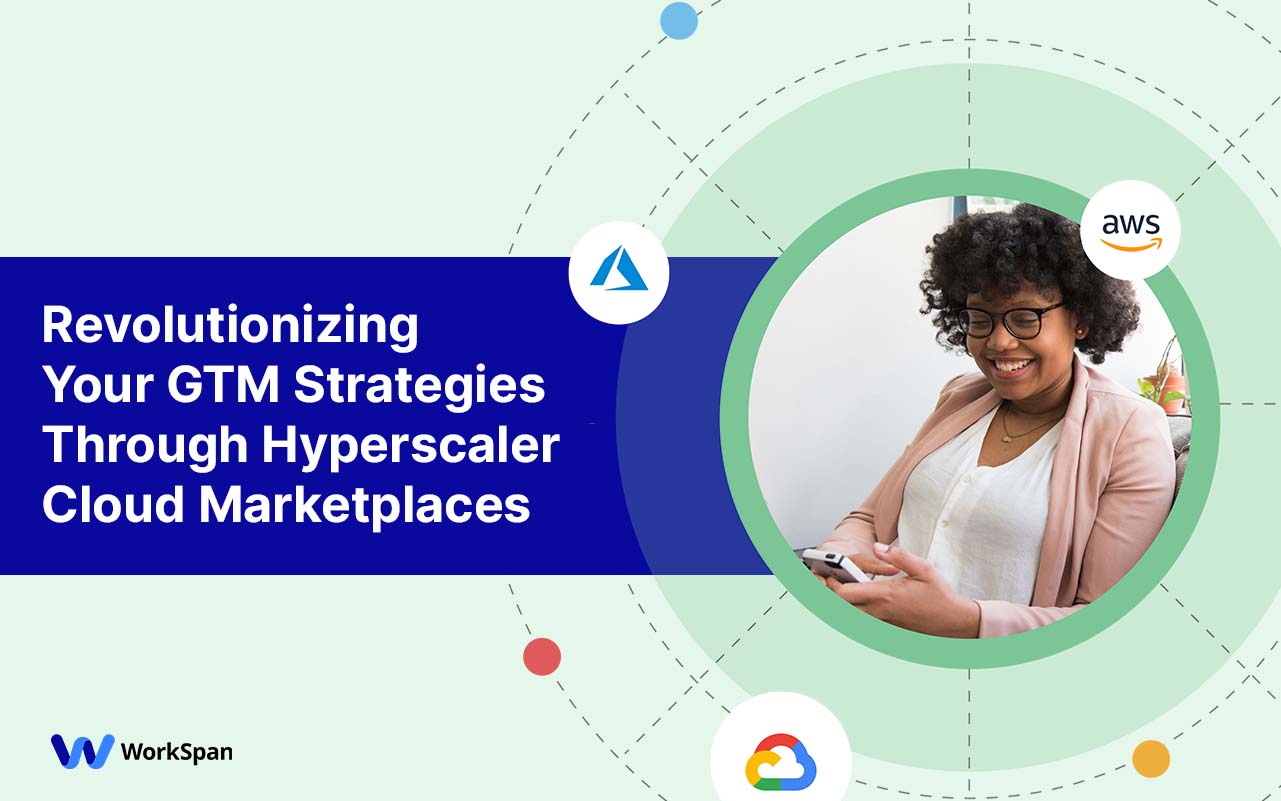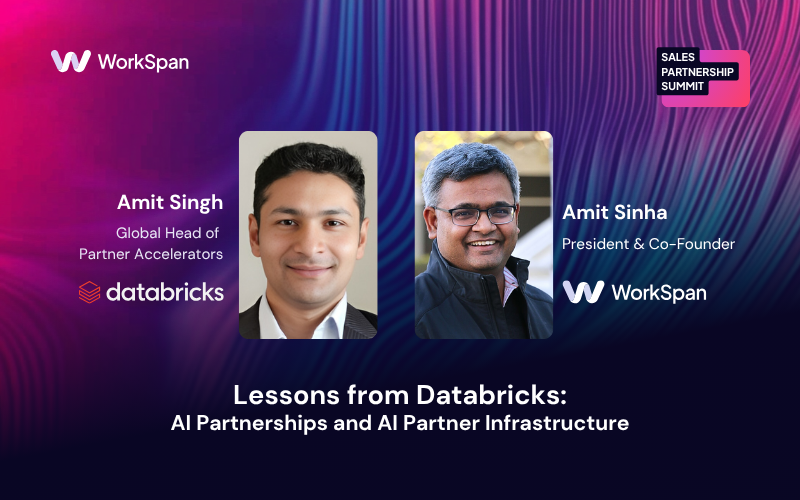
Hyperscaler cloud marketplaces have become a major disruptor in global technology channels and represent the fastest-growing route to market for SaaS, software, and cybersecurity solutions. According to Canalys, global sales of third-party vendor software and services through these marketplaces are predicted to reach US$45 billion by 2025, reflecting an impressive 84% compound annual growth rate (CAGR) over five years.
Plus, Canalys reports that 52% of partners globally acknowledge the likelihood of their customers buying through the top three hyperscaler marketplaces. So what does this mean for ISVs looking to get in on this success? It’s time to heavily invest in your go-to-market hyperscaler cloud marketplace strategy.
In order to help you do just that, we’re covering:
- Hyperscaler Cloud Marketplaces
- The Current State of Cloud GTM
- Best Practices for GTM Through Cloud Marketplace Strategy
- Looking Towards the Future
Let’s dive in!
Hyperscaler Cloud Marketplaces
Hyperscaler marketplaces are centralized platforms provided by major cloud service providers, often referred to as hyperscalers, such as AWS (Amazon Web Services), Azure (Microsoft), and GCP (Google Cloud Platform). These marketplaces serve as comprehensive ecosystems where users can access, deploy, and manage a wide range of cloud-based solutions, services, and applications.
Key characteristics of hyperscaler marketplaces include:
- Diverse Offerings: They host a variety of offerings from different vendors, including independent software vendors (ISVs) and established technology companies. This diversity provides users with a broad spectrum of solutions.
- On-Demand Services: Users can access cloud services on a flexible, pay-as-you-go, or subscription basis, allowing scalability and cost-effectiveness based on specific business needs.
- Streamlined Procurement: These marketplaces simplify the process of browsing, selecting, and purchasing cloud services through a unified platform, enhancing convenience and efficiency for users.
- Integration Capabilities: Many hyperscaler marketplaces offer integration capabilities with other tools, facilitating the connection of business applications, analytics, or collaboration platforms for a cohesive cloud ecosystem.
- Aggregated Billing and Management: Users benefit from features like aggregated billing and centralized management, allowing for better monitoring, control of cloud expenditures, and streamlined management of multiple services from a single interface.
- Community Engagement: Some hyperscaler marketplaces encourage community engagement, enabling users to share insights, reviews, and best practices. This fosters collaboration and enhances the overall user experience.
The Current State of Cloud GTM
Cloud marketplaces have become key players in the cloud GTM strategy, streamlining the process for businesses to access, deploy, and manage cloud solutions. This model offers a simplified procurement process, fostering vendor diversity and enabling users to choose from various offerings.
As these marketplaces continue to expand and evolve, their influence on the tech landscape grows, establishing them as essential components of the contemporary cloud computing ecosystem.
Many of the big players in the SaaS space amplified their success with strong cloud marketplace GTM strategies:
- Slack on AWS Marketplace: Slack, a popular team collaboration platform, partnered with AWS to offer its services through the AWS Marketplace. This collaboration allowed Slack to tap into AWS's extensive customer base, reaching organizations already using AWS services. It streamlined the procurement process for customers and facilitated seamless integration with existing AWS infrastructure.
- Datadog on Azure Marketplace: Datadog, a cloud monitoring and analytics platform, adopted a GTM strategy by joining the Azure Marketplace. By aligning with Azure, Datadog gained exposure to Azure's user base, providing users with an integrated solution for monitoring their Azure workloads. This approach enhanced Datadog's visibility and accessibility among Azure customers.
- MongoDB Atlas on GCP Marketplace: MongoDB, a leading NoSQL database provider, collaborated with Google Cloud Platform (GCP) to make MongoDB Atlas available on the GCP Marketplace.This partnership allowed users to easily deploy and manage MongoDB Atlas on GCP, leveraging the benefits of both platforms. It simplified the procurement process for GCP users and expanded MongoDB's reach within the GCP ecosystem.
- Snowflake on AWS and Azure Marketplaces: Snowflake, a cloud-based data warehousing platform, adopted a multi-cloud GTM strategy by offering its services on both AWS Marketplace and Azure Marketplace. This approach allowed Snowflake to cater to customers using different hyperscaler platforms, maximizing its market reach. Users could choose their preferred hyperscaler while benefiting from Snowflake's data warehousing capabilities.
Best Practices for GTM Through Cloud Marketplace Strategy
A successful GTM strategy through hyperscaler cloud marketplaces is defined by several key elements that contribute to effective planning, execution, and adaptation. Here are the defining characteristics of a robust GTM hyperscaler cloud marketplace strategy:
- Strategic Alignment: Align GTM initiatives with business goals, ensuring synergy with hyperscaler marketplace objectives.
- Targeted Audience Focus: Tailor strategies to specific audience segments within the cloud hyperscaler ecosystem for maximum impact.
- Collaborative Hyperscaler Partnerships: Foster robust partnerships with cloud hyperscalers such as AWS, Azure, or Google Cloud to leverage their marketplace strength.
- Agile Pricing Models: Implement flexible and transparent pricing strategies (such as private offers) that resonate with cloud hyperscalers and their diverse marketplace dynamics.
- Responsive to Marketplace Dynamics: Stay responsive to evolving hyperscaler marketplace trends, swiftly adapting strategies to capitalize on emerging opportunities.
- Compliance-Centric Governance: Adhere rigorously to hyperscaler marketplace rules and regulations, ensuring governance practices that build trust with partners and customers alike.
To implement such a strategy efficiently and without the hindrance of human error, companies can leverage advanced tools like WorkSpan. These collaborative platforms streamline communication, enhance visibility, and automate key aspects of GTM execution. Here's how:
- Automation of Key Processes: Automate routine tasks and processes, reducing the risk of human error and enhancing overall efficiency.
- Dynamic Strategy Adaptation: Facilitate real-time adaptation of strategies based on market changes and emerging opportunities.
- Efficient Collaboration: Streamline communication and collaboration among teams, ensuring seamless coordination on GTM initiatives.
- Enhanced Visibility: Provide real-time visibility into project status, metrics, and performance, enabling data-driven decision-making.
Leveraging tools like WorkSpan optimizes collaboration, enhances efficiency, and elevates success in the hyperscaler ecosystem. These platforms are integral in executing a comprehensive GTM strategy, addressing the complexities of hyperscaler cloud marketplaces.
Future Trends and Opportunities in Cloud Hyperscaler Marketplaces
In navigating the dynamic realm of hyperscaler marketplaces, predicting their evolution is paramount. Constant monitoring of trends, strategic partnerships, and market dynamics provides valuable insights. This proactive stance ensures organizations align their strategies with the evolving hyperscaler marketplace, fostering relevance and competitiveness.
Anticipating Emerging Technologies and Their Impact on Cloud GTM
With technology advancing rapidly, anticipating trends is critical for effective cloud Go-to-Market (GTM) strategies. Keeping abreast of technologies like artificial intelligence, edge computing, and blockchain helps organizations understand their impact on cloud GTM. This foresight allows businesses to strategically position themselves, leveraging innovative technologies for a competitive edge in the dynamic cloud solutions landscape.
Recommendations for Staying Ahead in the Rapidly Changing Cloud Solutions Marketplace
Staying ahead in the rapidly changing cloud solutions marketplace demands a proactive and adaptive mindset. Here are recommendations to navigate this dynamic landscape:
- Continuous Market Monitoring: Regularly assess hyperscaler marketplace trends, competitor strategies, and customer preferences for quick adaptation to changing dynamics.
- Agile Technological Adoption: Embrace an agile approach to adopting emerging technologies, ensuring a swift response to technological advancements in cloud hyperscalers.
- Strategic Partnerships: Forge strategic collaborations with key players in the cloud hyperscaler ecosystem, enhancing innovation and market presence.
- Customer-Centric Approach: Prioritize a customer-centric approach, understanding evolving needs and tailoring solutions to meet changing demands in cloud solutions.
- Flexibility in GTM Strategies: Maintain flexibility in cloud GTM strategies, allowing for rapid adjustments based on technological shifts and market developments in hyperscaler marketplaces.
By focusing on these pillars, organizations can predict the trajectory of hyperscaler marketplaces and position themselves as innovators in the ever-evolving landscape of cloud solutions.
Heading
Heading 1
Heading 2
Heading 3
Heading 4
Heading 5
Heading 6
Lorem ipsum dolor sit amet, consectetur adipiscing elit, sed do eiusmod tempor incididunt ut labore et dolore magna aliqua. Ut enim ad minim veniam, quis nostrud exercitation ullamco laboris nisi ut aliquip ex ea commodo consequat. Duis aute irure dolor in reprehenderit in voluptate velit esse cillum dolore eu fugiat nulla pariatur.
Block quote
Ordered list
- Item 1
- Item 2
- Item 3
Unordered list
- Item A
- Item B
- Item C
Bold text
Emphasis
Superscript
Subscript





.png)